"Every garden-maker should be an artist along his own lines.
That is the only possible way to create a garden,
irrespective of size or wealth."
- Vita Sackville West
 |
| Spires of foxglove and larkspur against a stippled background of red geum, brushed with golden flecks of Stipa gigantea... |
As beezy May slipped into sunny June, we mistook the lengthening days for the onset of summer - only to find that a few hours of intense heat inevitably gave way to more rainy squalls and cloud-filled skies. It looks as if our jet stream has got stuck again!
 |
| Christina lending scale to a Lizard Orchid |
We try and do a daily walk no matter what, in the hope that exercise will loosen those muscles for a spot of gardening later on.
As mentioned before, this unusually damp spring has enriched our meadows with wild flowers, including spectacular orchids like the one on the right which must have been a meter tall.
In previous years, these lizard orchids have been far less numerous in our chalky grassland, and less impressive at half the size.
 |
| Himantoglossum hircinum or Lizard Orchid |
Viewed up close, you can appreciate the orchid-like maroon spots on its strange 'tentacles' - which might just be thought to resemble lizards.
 |
| Ammi visnaga 'Green Mist' (available from Chiltern Seeds) |
Elsewhere hedgerows are sprouting hefty umbellifers like hogweed, which may irritate the skin but are undeniably handsome architectural plants.
You certainly wouldn't want to pick any to take indoors but it's nice to cultivate your own type of cow parsley in the form of Orlaya grandiflora or Ammi visnaga, either of which can be used in a vase to complement other garden flowers.
Although easy to grow from seed, I find that Ammi visnaga is a bit too big and bushy for our small garden, although its green-tinged flowers do look good in a vase. Orlaya, on the other hand, fits perfectly with our loose style of cottage gardening and seeds itself quite easily.
Mixed Planting
Mixed Planting
 |
| Orlaya grandiflora co-habiting with geraniums, yellow geum and phlomis |
 |
| Foxgloves with aquilegia, gilded by panicles of Stipa gigantea and interspersed with red Geum chiloense 'Mrs Bradshaw' |
Creating a tapestry in your garden may look random but relies on the experience of knowing which plants will grow best in certain areas. In the island bed above, partly shaded by a tall ash tree, are perennials and biennials suited to a woodland clearing where soil is dryish.
There is, however, enough direct sunlight for a single Stipa gigantea to flourish and cast its magic over the assembled party.
Another thing to bear in mind is that you want to have as much contrast as possible - in both colour and form - in order to showcase individual plants.
We recently started using the excellent dark- leaved Physocarpus opulifolius, even though I read that it's best suited to acid soils whilst ours actually contains a lot of chalk. (Home-made compost and leaf-mould will help to redress the balance when planting.)
So far, it's held its colour well and gets enough sunlight to keep the leaves nice and dark, with hints of bronzy-red.
 |
| Phlomis russeliana with Physocarpus opulifolius 'Lady in Red' |
We recently started using the excellent dark- leaved Physocarpus opulifolius, even though I read that it's best suited to acid soils whilst ours actually contains a lot of chalk. (Home-made compost and leaf-mould will help to redress the balance when planting.)
So far, it's held its colour well and gets enough sunlight to keep the leaves nice and dark, with hints of bronzy-red.
 |
| Sambucus nigra 'Black Lace' |
Sambucus nigra is another effective shrub for contrast and this variety, 'Black Lace', has finely cut leaves to create even more interest to the eye. Its pink blooms are a little at odds with our surrounding splashes of red geum - whose flowers have now been thinned out so they don't look too offensive!
 |
| Linaria purpurea 'Canon Went' |
Teaming it with this delicate pink Linaria purpurea would probably be a better bet and we can easily move a couple of plants in autumn, or even grow some more from seed.
Cultivating perennials from seed, rather than simply filling a trolley at the garden centre, gives you more flexibility in choosing the right size/variety to suit your space.
I'm always excited to see how my seeds turn out - usually better than imagined - and because it's quite cheap to produce several plants, there's less hesitation in pulling out or moving specimens which don't really work. Motto: Be ruthless and edit!
 |
| Geranium 'Ann Folkard' threading its pale leaves over a purple sage, with small aquilegia flowering in front |
Herbs, too, offer great scope for contrast in leaf colour and texture, particularly if you mix in the odd perennial. We find that Dianthus gratianopolitanus, with its magenta flowers and mat-forming grey-green foilage works well and can be trimmed back to a neat mound.
 |
| 'Couscous' enjoys the warm stones surrounding our herb bed |
Aside from the continus (smoke bush) which provides wonderful leaf colour, all other flowers were grown from seed sent by Chiltern Seeds in Wallingford.

No comments:
Post a Comment